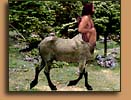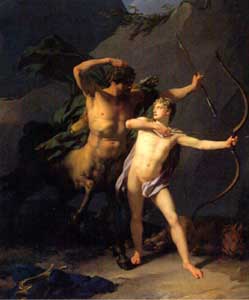 |
 |
CENTAURS
Creatures which are half human, half horse. In some of the earliest depictions they have an entirely human body with human forelegs but with the back half of a horse growing out of their backs, later the standard represented develops: a horse's body with a human torso growing out of it (see the various representations under Monsters). Both Herakles and Theseus engage in battles with Centaurs (Centauromachies). Centaurs typically use weapons taken directly from nature like rocks or branches.
Centaurs are usually depicted battling as a group against their human adversaries, but some individuals have a prominent in mythology. Nessos (or Nettos) was the centaur who tried to rape Herakles' wife Deianira and gave her the poisonous 'love potion' that would eventually kill Herakles. Pholos was the host of Herakles - his hospitality led to Herakles' centauromachy (see Apollodoros). The most famous 'good' centaur was Cheiron, the immortal centaur who was wounded by Herakles and allowed by Zeus to give up his immortality rather than live in agony for eternity (Apollodoros' statement that he gave his immortality to Prometheus is a puzzle as Prometheus was immortal anyway, perhaps Herakles, who did become immortal, is meant.) Cheiron was entrusted with the upbringing of the young Jason and Achilles.
In the Theogony Cheiron is the offspring of Phillyra
and elsewhere his father is identified as Kronos who had taken on the form
of a horse to mate with Phillyra. Cheiron is therefore a unique being.
Centaurs in general are explained by Pindar (Pythian 2) as the children
of a human called Kentauros, son of Ixion and Hera, who mated with horses.

 |
The centaur has been suggested to have originated
in Babylonia during the late 2nd millennuim B.C. It is thought the Kassites,
a barbarian culture that migrated from Iran or further east to the Fertile
Crescent around 1750 B.C., may have been responsible for creating the myth
of the centaur. The Kassites, who fought with Egypt and Assyria for Near
East supremacy, set up stones to mark the boundries of their lands. Figures
of gods of guardian spirits were carved upon the stones, and some of these
were
half-man and half-horse beings.
It took centuries before the horse was common in the Near East, and it
is possible the Kassites
helped introduce equines to the region. As barbarian nomads, they might
have ridden their horses,
and to the Near-Eastern cultures who were used to chariots pulled by donkeys,
the sight of a
foreign men mounted on horses might have caused confusion. Hence, the rumors
of half-men and
half-horse beings may have grown.
They were depicted as hunters with a bow
as their principal weapon. As the myth of centaurs grew, it is thought
the Hittite culture may have imported tales of half-men and half-horse
beings to the Mycenean Greeks.
The name centaurs signifies 'those who round up bulls' and so alternatively, the idea of the centaur may have originated from the cattle breeders of Thessaly in northern Greece who spent much of their time on horseback and whose manners were rough and barbarous. Yet another possible origin of the centaurian myth suggests the original centaurs were Cimmerian and Scythian raiders, rough riding nomads from the north, who often invaded Thrace in the north-east.
Once adopted into classical mythology, the Greeks believed a reprehensible
mortal man named
Ixion had founded the race. Ixion committed the outrageous offense of daring
to attempt to seduce
Hera, wife of Zeus and queen of heaven. To see how far Ixion's impudence
would go, Zeus formed
a cloud image of Hera and substituted it for the goddess. A monster, Centaurus,
was born of this
strange union, and when grown to maturity, he united with the mares of
Mount Pelion and produced
the race of centaurs.
Another legend portrays Chiron as the first centaur.
Chiron had begun life as a Titan, a son of Cronus and
the ocean nymph Phylyra. He dared to make war
against the young gods of Olympus but was defeated.
Apollo, the god of light and reason, punished Chiron
by making him half-horse. Chiron had been educated
by the gods and in turn undertook the instruction of
hero after hero; Actaeon, Jason, Castor and
Polydeuces, and Achilles. Each served an
apprenticeship with Chiron in the wilderness. Chiron's
fate was an unhappy one because he fell wounded by
a poisoned arrow in a tragic accident. The arrow
came from the quiver of a good friend, Heracles
(Hercules). There was no antidote to its poison and to
escape the wound's unending agony, Chrion
renounced immortality in favour of his fellow-Titan
Prometheus. Zeus then generously set the kindly
centaur's image in the heavens as the constallation
Sagittarius, the Archer.
The Greeks made the centaur population over to represent a race associated
with drunkeness and
physical violence and followers of Dionysus, the god of wine. In Greece,
they inhabited Mount
Pelion in Thessaly located in northern Greece.
The principal myth associated with the centaurs concerns the war with the
Lapiths, a neighboring
Thessalian nation. The centaurs had claimed King Pirithous' kingdom and
the king tried to make
peace. The centaurs were invited to attend the wedding of Pirithous to
Hippodamia (or Deidamia)
as friends but they got drunk and tried to forcibly seize the Lapith women.
One of the centaurs,
Eurytion, even tried to carry off the bride but was restrained by Theseus.
A long battle ensued and
the Lapiths eventually emerged victorious. The centaurs were driven to
the frontiers of Epirus and
sought shelter on Mount Pindus.
Heracles played a part in the myth of the centaurs in his
visit to the centaur Pholus during his pursuit of the
Erymanthian Boar. A fight broke out among the centaurs
when they smelled an open jar of wine given to Pholus by
Dionysus. Heracles drove them off with his arrows
poisoned with the Hydra's venom. As a result of this fight,
both Pholus and Chiron were accidently scratched with
poisoned arrows and died. One of the centaurs, Nessus,
sought vengeance on Heracles for the harm he had done
to his race. After Heracles married Deianira, they were
crossing the flooded river Evenus in Aetolia on their way
home. Nessus offered to carry Deianira over the river on
his back and then tried to rape her. Heracles caught
Nessus and shot him with a poisoned arrow. As he died,
Nessus seemingly tried to redeem himself by offering
some of his blood to Deianira. He said if Heracles lost his
love for her, she could win it back by smearing a tunic
with the blood and giving it to Heracles to wear. Years
later, when Deianira resented her husband's faithlessness,
she did as Nessus proposed. It turned out the blood was
poisoned and Heracles met a horrible death wrapped in
the burning garment.
Today in Greece, people will tell you of kallikantzaroi, 'good centaurs',
who appear to be
descended from the old legendary creatures. But the 'good' which has been
prefixed to their names
in modern times is a precaution taken out of fear, as when a superstitious
northerner refers to elves
or fairies as 'the good people'. The kallikantzaroi come up out of the
ground on winter nights. They
are hoofed, shaggy, swift, stupid and mischievous. In short they are 'monsters'
in the modern, and
not the ancient, sense.

Creatures part human and part horse. The centaurs were descendants of
Centaurus, a son of the music god Apollo. Most
centaurs were governed by the bestial half of their double nature.
Their behavior was uncouth, and a very small amount of wine
drove them wild.
When Heracles was entertained by Pholus, one of the few civilized centaurs,
he made the mistake of demanding the guest's
prerogative of a beaker of wine. Pholus could not refuse, though he
hesitated before unearthing a jug of the liquid which he kept
buried underground for fear of just the sort of consequence which now
ensued.
As soon as Pholus uncapped the jar of wine, his brothers caught scent
of it on the wind from more than a mile away. Driven
instantly to madness, they attacked Heracles, and the hero barely succeeded
in driving them off with flaming arrows.
Wine also caused the centaurs to fight with other guests at the wedding
feast of Theseus's friend Peirithous. It was on this
occasion that they destroyed the supposedly invulnerable Caeneus.
On another occasion, a centaur named Nessus offered to ferry Heracles'
wife across a torrent on his back. Midway, his animal
nature got the better of him and he tried to force his attentions on
his passenger. She shrieked and Heracles came running. He
killed Nessus with a single arrow through the heart.
Chiron was not an ordinary centaur, having ended up with his horsely
half by virtue of his father, the god Cronus, taking the
form of a horse when Chiron was conceived. Chiron became renowned for
his civility and wisdom. He served as tutor to many
famous heroes, including Heracles and Jason. He taught music and medicine
as well as the skills of the hunt.
BACK | Tamboura's Sanctuary | LINKS | Gods and Monstrocities | Gods Page |